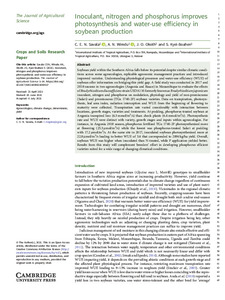| dc.contributor.author | Engoke, C. |
| dc.contributor.author | Wiredu, A. |
| dc.contributor.author | Omondi, J.O. |
| dc.contributor.author | Boahen, S. |
| dc.date.accessioned | 2022-09-23T12:30:28Z |
| dc.date.available | 2022-09-23T12:30:28Z |
| dc.date.issued | 2021 |
| dc.identifier.citation | Engoke, C., Wiredu, A., Omondi, J.O. & Boahen, S. (2021). Inoculant, nitrogen and phosphorus improves photosynthesis and water-use efficiency in soybean production. Journal of Agricultural Science, 159(5-6), 349-362. |
| dc.identifier.issn | 0021-8596 |
| dc.identifier.uri | https://hdl.handle.net/20.500.12478/7804 |
| dc.description.abstract | Soybean yield within the Southern Africa falls below its potential despite similar climatic conditions across some agroecologies, replicable agronomic management practices and introduced improved varieties. Understanding physiological processes and water-use efficiency (WUE) of soybean offer information on bridging this yield gap. A field study was conducted in 2017 and 2018 seasons in two agroecologies (Angonia and Ruace) in Mozambique to evaluate the effects of Bradyrhizobium diazoefficiens strain USDA110 formerly known as Bradyrhizobium japonicum inoculant, nitrogen and phosphorus on nodulation, physiology and yield of non-promiscuous (Safari) and promiscuous (TGx 1740-2F) soybean varieties. Data on transpiration, photosynthesis, leaf area index, radiation interception and WUE from the beginning of flowering to maturity were collected. Transpiration rate varied considerably with interaction between locations, growth stages, varieties and treatments. At podding, phosphorus-treated soybean at Angonia transpired less (6.3 mmol/m2/s) than check plants (6.6 mmol/m2/s). Photosynthesis rate and WUE were distinct with variety, growth stages and inputs within agroecologies. For instance, in Angonia 2018 season, phosphorus fertilized TGx 1740-2F photosynthesized more at flowering (25.3 μmol/m2/s) while the lowest was phosphorus-treated Safari at podding with 17.2 μmol/m2/s. At the same site in 2017, inoculated soybean photosynthesized more at 22.8 μmol/m2/s leading to better WUE of 3.6 that corresponded to 2894 kg/ha yield. Overall, soybean WUE was higher when inoculated than N-treated, while P application yielded better. Results from this study will complement breeders’ effort in developing phosphorus efficient varieties suited for a wide range of changing climatical conditions. |
| dc.description.sponsorship | Consortium of International Agricultural Research Centers |
| dc.format.extent | 349-362 |
| dc.language.iso | en |
| dc.subject | Agroecology |
| dc.subject | Climate Change |
| dc.subject | Yields |
| dc.subject | Grain Legumes |
| dc.subject | Soybeans |
| dc.title | Inoculant, nitrogen and phosphorus improves photosynthesis and water-use efficiency in soybean production |
| dc.type | Journal Article |
| cg.contributor.crp | Grain Legumes |
| cg.contributor.affiliation | International Institute of Tropical Agriculture |
| cg.coverage.region | Africa |
| cg.coverage.region | Southern Africa |
| cg.coverage.country | Mozambique |
| cg.coverage.country | Zambia |
| cg.coverage.hub | Southern Africa Hub |
| cg.researchtheme | Plant Production and Health |
| cg.researchtheme | Social Science and Agribusiness |
| cg.identifier.bibtexciteid | ENGOKE:2021 |
| cg.isijournal | ISI Journal |
| cg.authorship.types | CGIAR Single Centre |
| cg.iitasubject | Agribusiness |
| cg.iitasubject | Agronomy |
| cg.iitasubject | Climate Change |
| cg.iitasubject | Food Security |
| cg.iitasubject | Grain Legumes |
| cg.iitasubject | Plant Breeding |
| cg.iitasubject | Plant Production |
| cg.iitasubject | Soybean |
| cg.journal | Journal of Agricultural Science |
| cg.notes | Published online: 07 Sep 2021 |
| cg.accessibilitystatus | Open Access |
| cg.reviewstatus | Peer Review |
| cg.usagerightslicense | Creative Commons Attribution 4.0 (CC BY 0.0) |
| cg.targetaudience | Scientists |
| cg.identifier.doi | https://dx.doi.org/10.1017/s0021859621000617 |
| cg.iitaauthor.identifier | Canon Norris Savala Engoke: 0000-0002-9667-2324 |
| cg.iitaauthor.identifier | Alexander Nimo Wiredu: 0000-0002-8487-4340 |
| cg.iitaauthor.identifier | Stephen Boahen Asabere: 0000-0001-8946-401X |
| cg.futureupdate.required | No |
| cg.identifier.issue | 5-6 |
| cg.identifier.volume | 159 |
| cg.contributor.acknowledgements | The authors greatly acknowledge financial support from the Consortium of International Agricultural Research Centers
(CGIAR) through the Research Program on Grain Legumes and Dryland Cereals (CRP-GLDC) in Mozambique. Thanks to the IITA technical staff at Angonia and Gurue stations in Mozambique for managing the trials and collecting of field-related data. |

